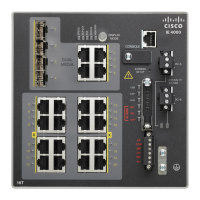709
Configuring IP Multicast Routing
Configuring IP Multicast Routing
Using Auto-RP and a BSR
If there are only Cisco devices in you network (no routers from other vendors), there is no need to configure a BSR.
Configure Auto-RP in a network that is running both PIMv1 and PIMv2.
If you have non-Cisco PIMv2 routers that need to interoperate with Cisco PIMv1 routers and multilayer switches, both
Auto-RP and a BSR are required. We recommend that a Cisco PIMv2 router or multilayer switch be both the Auto-RP
mapping agent and the BSR.
If you must have one or more BSRs, we have these recommendations:
Configure the candidate BSRs as the RP-mapping agents for Auto-RP. For more information, see Configuring
Auto-RP, page 699 and Configuring Candidate BSRs, page 706.
For group prefixes advertised through Auto-RP, the PIMv2 BSR mechanism should not advertise a subrange of these
group prefixes served by a different set of RPs. In a mixed PIMv1 and PIMv2 domain, have backup RPs serve the
same group prefixes. This prevents the PIMv2 DRs from selecting a different RP from those PIMv1 DRs, due to the
longest match lookup in the RP-mapping database.
Follow this procedure to verify the consistency of group-to-RP mappings. This procedure is optional.
BEFORE YOU BEGIN
Review the Auto-RP and BSR Configuration Guidelines, page 686.
DETAILED STEPS
Monitoring the RP Mapping Information
To monitor the RP mapping information, use these commands in privileged EXEC mode:
show ip pim bsr displays information about the elected BSR.
show ip pim rp-hash group displays the RP that was selected for the specified group.
show ip pim rp [group-name | group-address | mapping] displays how the switch learns of the RP (through the BSR
or the Auto-RP mechanism).
Command Purpose
1. show ip pim rp [[group-name
| group-address] | mapping]
On any Cisco device, display the available RP mappings.
(Optional) For group-name, specify the name of the group about
which to display RPs.
(Optional) For group-address, specify the address of the group
about which to display RPs.
(Optional) Use the mapping keyword to display all group-to-RP
mappings of which the Cisco device is aware (either configured
or learned from Auto-RP).
2. show ip pim rp-hash group On a PIMv2 router or multilayer switch, confirm that the same RP is the
one that a PIMv1 system chooses.
For group, enter the group address for which to display RP
information.

